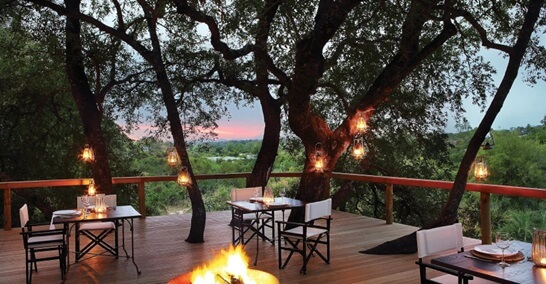Epic Dining, Amazing Rooms, and...No Plastic? That’s the Aim of This Luxury Hospitality Group
Relais & Chateaux is embarking on an ambitious journey to enhance the sustainability of its global network of hotels and restaurants, all renowned for their culinary excellence. For those well-acquainted with the world of culinary-focused travel, Relais & Chateaux needs no introduction. Established in France in 1954, this association of independently owned luxury hotels has long been synonymous with extraordinary hospitality centered around dining experiences that warrant journeys of their own. As it approaches its 70th anniversary, the company boasts a portfolio of nearly 600 hotels and 800 restaurants around the globe, collectively amassing an impressive 340 Michelin stars.
In its ongoing mission to contribute to a better world through the celebration of cuisine and hospitality, Relais & Chateaux's new president, Laurent Gardinier, is pushing the envelope further in the realm of sustainability. The organization unveiled its inaugural sustainability report at the close of 2022, outlining its objectives and impact assessment. Prior to this, in 2014, the association presented its Relais & Chateaux Vision manifesto to UNESCO, which outlined 20 commitments concerning environmental conservation, sustainable gastronomy, and social empowerment. In 2024, the organization has plans to deepen its collaboration with UNESCO. In the coming year, Relais & Chateaux will also commence efforts to evaluate aspects such as waste management and single-use plastic with the assistance of both its inspectors and third-party experts.
AFAR recently had the opportunity to speak with Gardinier, a co-owner of Relais & Chateaux Domaine Les Crayères in Champagne and Le Taillevent restaurant in Paris, where he shared insights into the organization's future direction, from supporting member hotels in assessing their sustainability impacts to upcoming destinations where travelers can expect to discover more Relais & Chateaux properties.
This interview has been condensed for brevity.
What are the most significant aspects travelers should know about Relais & Chateaux today? We boast the largest collection of Michelin stars of any hospitality brand worldwide. When you aggregate all our revenues, it amounts to $2.8 billion in U.S. dollars, with approximately 42,000 individuals working within the extended Relais & Chateaux community. Furthermore, we operate as a nonprofit organization, with the brand being collectively owned by our 580 members. The values we uphold are of utmost importance to us—values such as camaraderie, aligning with the communities where we operate, culinary excellence, and, of course, sustainability. The fact that we function as an association underscores our commitment to mutual support rather than intense competition among our members.
What is your vision for sustainability at Relais & Chateaux? When we discuss sustainability, we must be cautious about the peril of greenwashing. Given our presence in 60 different countries, consistency and ambition are paramount, recognizing that efforts vary from one destination to another. For instance, when I converse with the owner of Great Plains Conservation, my friend Dereck Joubert, he's engaged in rhino conservation in Botswana, while another member might be focusing on the elimination of single-use plastics in guest rooms as part of their sustainability goals. My goal is to identify the necessary tools to advance these endeavors.
What plans do you have for measuring sustainability in the near future? At present, our inspectors evaluate the quality of our hotel experiences. This process is rigorous and subject to regulation, with regular audits conducted by the French government, even extending to our inspection of other organizations. While we haven't implemented this yet, it underscores our dedication to the process. Our intention is to incorporate sustainability criteria into our assessments for both existing and prospective members. The timeline for identifying these relevant criteria is within the next six months, and we aim to unveil our comprehensive plan within a year.
How might this manifest in practice? Sustainability evaluation encompasses two dimensions. First, there is the guest experience—our inspectors will assess sustainability from the guest's perspective. What sustainability initiatives are visible to the guest? The second dimension involves the technical aspects of sustainability, particularly those behind the scenes. How does the property manage its water resources? What are their waste management practices? For complex tasks like composting, there are various approaches, and we won't require our quality inspectors to delve into the intricacies of back-of-house operations or supplier engagements. They lack the technical and engineering expertise required. As such, we plan to collaborate with a reputable organization possessing the necessary technical knowledge.
Can you tell us more about the sustainability committee you've established within Relais & Chateaux? I recognized that there is a wealth of knowledge within our membership concerning sustainability, which we have yet to fully harness. Members like Dereck Joubert of Great Plains Conservation and Malik Fernando of Resplendent Ceylon in Sri Lanka bring invaluable insights. Consequently, I've instituted a sustainability committee within the association, a governing body tasked with guiding us, identifying challenges, and ensuring we remain on the right track.
You've appointed Mauro Colagreco of the three-Michelin-starred Mirazur in France, the first restaurant in the world to receive Plastic Free Certification, as vice president dedicated to environmental responsibility. How will he impact sustainability from a culinary perspective? Efforts to drive change, such as the transition to a plastic-free approach, often commence with celebrated chefs like Mauro. Gradually, their actions set in motion a ripple effect that transforms the culinary industry as a whole. It's akin to the concept of seasonality in relation to local ingredients. Presently, a fine-dining establishment would not consider serving tomatoes or truffles out of season. Two decades ago, serving these ingredients year-round was considered gourmet.
When we acquired Les Crayeres in 2000, it already boasted a renowned Michelin two-star restaurant, and we served truffles throughout the year. This was a fundamental aspect of the Relais & Chateaux experience. Change began with vegetables, and today, with Giuliano Sperandio, our Italian chef, certain fish are not served out of season. Over the next decade, we anticipate the emergence of seasonality in the context of meat consumption. People will become more aware that they cannot consume lamb throughout the year. The transformation begins in high-end dining establishments and gradually extends to other culinary realms. Chefs without two or three Michelin stars take cues from their peers, fostering a cultural shift.
What regions can we expect Relais & Chateaux to expand into in the near future? Our expansion model does not revolve around adding a specific number of properties to sustain our headquarters. We are well-represented in Western Europe, the United States, South America, and Japan. However, our presence in China and India is relatively limited. The global interest in Nordic cuisine is on the rise, and thus, we are gradually expanding within this region. Expansion follows a rigorous process, requiring a consistent level of culinary excellence, service, and architecture at the small property level in each destination. Such attributes are more readily found in mature markets.
What are the prerequisites for a property to become a Relais & Chateaux hotel or restaurant? At Relais & Chateaux, we have approximately 500 criteria for hotels and around 180 for standalone restaurants. Our roster comprises 10 to 15 anonymous inspectors. Each year, we receive approximately 500 applications but select only about 15 to 20, depending on the circumstances.
Are there any other Relais & Chateaux properties you've recently visited and admired? I've had the privilege of visiting several remarkable properties. Casa Palopó on Lake Atitlán in Guatemala, owned by the remarkable Claudia Bosch and her children, left a lasting impression. The hotel's grounds border the serene lake and feature a beautifully manicured garden. Gazing beyond, you're treated to a breathtaking view of a colossal volcano. In the mornings, shrouded in mist, the peak remains concealed, but as the wind stirs, it unveils the magnificent mountain. This experience was a delightful surprise.
I also had the opportunity to explore Duba Plains Camp in Botswana, as well as Jabulani and Londolozi Game Reserve in South Africa. What struck me was how each of these properties beautifully reflects the unique personality of their owners. At Jabulani, as the sun sets, you can sit by a tranquil lake, surrounded by elephant families strolling nearby. It's moments like these that make you pause and wonder, "Am I really working?" I feel fortunate to witness these exceptional experiences.

